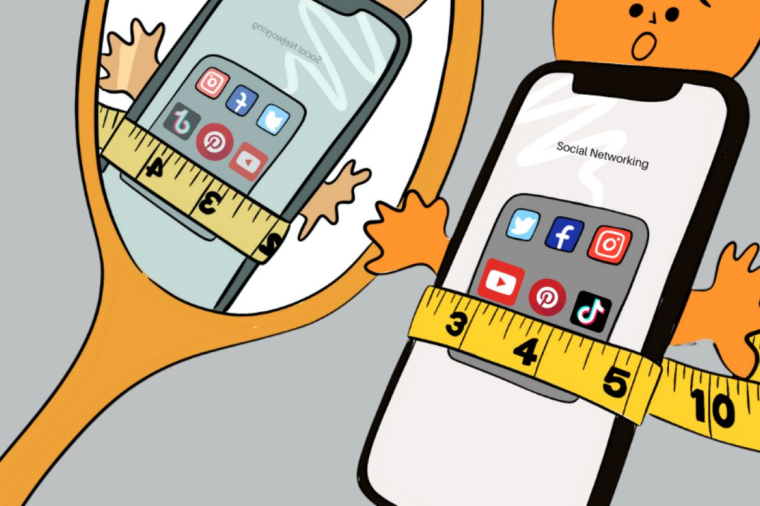Hello, and welcome back to my blog! For my inquiry project, I chose to research the topic of “How does the portrayal of beauty standards by the media contribute to the ongoing presence of body dysmorphia?” I chose to research this by breaking my inquiry question into 3 sub questions, and I will be addressing the second sub-question today.
For my second round of research, I researched the topic, “What specific types of media (ex. social media, television, etc.) are most influential in shaping beauty standards and contributing to body dysmorphia?”
When talking about what types of media are most influential in shaping beauty standards and contributing to body dysmorphia among society, there are more than a couple main types. Today, I will be focusing on the 5 most influential forms of media that continue to affect beauty standards and contribute to body dysmorphia, among many others. The top 5 include, social media, television, movies, music videos, and advertising. To further understand how these various types of media strongly contribute to body dysmorphia and the idea of unrealistic beauty standards, I will be digging deeper to understand each on its own.
Social Media (1):
In recent years, we have been hearing more and more about how much of an impact social media continues to have on our mental health. During the first week of the COVID-19 pandemic, researchers found, a 61% increase in social media usage, resulting in harsh impacts on mental health. This further explains, how social media platforms continue to contribute to negative and positive body image, but in particular, further negative body image through constant exposure to unrealistic body standards. The main reasons for this include because of how social media creates unrealistic beauty standards, increase comparison between people, cause people to have obsessive and compulsive thoughts, all leading to many mental health risks, one of the most important in this context being, body dysmorphia. To mitigate these effects, individuals are encouraged to be mindful of their social media usage, seek professional help if necessary, and strive to develop a positive body image through supportive and realistic online interactions.
Television (2):
Although many may not realize, television also has a significant influence on body dysmorphia, affecting viewers’ perceptions of their own bodies and contributing to body image issues. This impact is largely due to the portrayal of idealized body standards and the frequent showcasing of unrealistic physical appearances. This connects to how many television series continue to cast actors who fit the ‘perfect body standards’ leading to those who don’t relate to them, questioning and obsessing over why their appearance. Television often promotes a narrow standard of beauty, which can lead to increased body dissatisfaction and the development of BDD symptoms. People with BDD may engage in behaviors like mirror checking and camouflaging to cope with the flaws they believe they hold.

Movies (3):
Movies, much like social media and television also continue to be one of the main reasons contributing to body dysmorphia. Movies continue to also add to unrealistic body standards, comparison and negative self-image, and objectification and idealization of oneself. Addressing these influences involves promoting media literacy, encouraging diverse and realistic portrayals of bodies in films, and fostering a culture that values individuals beyond their physical appearance.
A positive contribution the movie industry has made on this issue however, is how directors and producers are trying to remove the stigma behind it by making it a more openly talked about topic. Movies like To the Bone, I feel Pretty, and Dying to be Perfect: The Ellen Hart Pena Story all address ideas related to body image issues and body dysmorphia, working towards making it a safer topic to openly talk about.

Music Videos (4):
Music videos have a significant impact on body image as research shows around 30% of individuals agreed music videos often lead to negative body image issues. These videos often show artists and models with seemingly perfect bodies, setting unrealistic beauty standards. Advanced editing techniques and filters further enhance these images, making it hard for viewers to distinguish between reality and digitally altered perfection. This constant exposure can lead to comparison and dissatisfaction with one’s own body, contributing to low self-esteem and body dysmorphic disorder. Understanding these influences can help us become more critical consumers of media and promote a healthier body image culture.
Advertising (5):
The constant bombardment of unrealistic portrayals of beauty in commercials and magazines can create a distorted view of what is considered normal or attractive. Advertisements frequently feature models and celebrities who conform to narrow standards of beauty, which can make young people feel dissatisfied with their own bodies. This pressure to measure up to these unattainable ideals can lead to low self-esteem, eating disorders, and other mental health issues.
Thank you so much for reading my blog post and joining me on learning about the specific types of media that are most influential in shaping beauty standards and contributing to body dysmorphia. In my next blog post, I look forward to researching about “How have beauty standards affected the number of teenagers affected by BDD’s every year?“
I look forward to having you follow me on this journey, happy reading!
Citations –
- The relationship between social media and body dysmorphia: D’amore. D\’Amore Mental Health. (2024, March 29). https://damorementalhealth.com/social-media-and-body-dysmorphia/
- Eating disorders are not the same as body dysmorphic disorder (and why it matters). International OCD Foundation. (2024, March 5). https://iocdf.org/expert-opinions/eating-disorders-not-the-same-as-bdd/
- Find a therapist near you: Local psychologists & counsellors. TherapyRoute. (n.d.). https://www.therapyroute.com/article/movies-about-body-dysmorphic-disorder-mental-health-related-films-by-e-sinisi
- How music impacts body image. How Music Impacts Body Image. (n.d.). https://withinhealth.com/explore-articles/how-music-impacts-body-image
- Looking good, feeling… not so good: The impact of advertising and social media on Body Image. Welcome to Cranfield University. (n.d.). https://www.cranfield.ac.uk/som/thought-leadership-list/looking-good-feeling-not-so-good-the-impact-of-advertising-and-social-media-on-body-image



Hi Anannya!
This blog post provides an amazing analysis of how various forms of media—social media, television, movies and music videos shape beauty standards and contribute to body dysmorphia. It’s insightful to see how each medium impacts our perception of beauty and mental health. A really good information resource to support loved ones is https://nedic.ca/